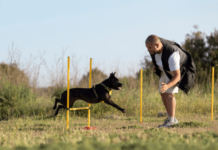Last Updated on December 13, 2021 by Dogs Vets
How to Be a Great Dog Owner
Every responsible dog owner wants to care for their dog as they would their own child.
They rely on us for just about everything from food and medical care to fun and affection, so it is not an understatement to say that being a dog owner can be stressful. Of course, this stress is usually more than made up for in the joy, comfort, and unconditional love they offer in return.
It is important to understand the needs of specific breeds of dog in terms of diet, exercise, and grooming, but in general terms, this blog explains what you can do to ensure your dog has the healthiest and happiest life they can.
Recognize and alleviate stress
It is not always easy to tell when a dog is feeling anxious or stressed, but high levels of the stress hormone cortisol can cause health problems if left unchecked.
Potential signs of stress in dogs include trembling, shaking (when not cold or wet), excessively licking their lips or yawning, hiding, chewing, or licking at their paws and nails, or a reluctance to be touched.
Stress has also been linked to destructive behaviors around the home. Click here for tips on reducing stress in dogs.
A smart way to improve your pet’s emotional state is to prepare some enjoyable toys to distract them from anything they shouldn’t chew or bite. Fetch balls or antlers for dogs can pretty much help calm your anxious or sensitive dogs down.
Make sure you consider the material and the cleaning task caused by the toy when choosing a toy.”
Make plans for when you are not going to be around
While we might want to spend all day every day with our dog, the reality is that most people also need to work.
If you are going to be away for several hours at a time, you might leave the TV on, give them treat-dispensing toys, or spray the home with pheromones that relax them.
You might also consider hiring a dog walker, sitter, dropping them off at a daycare, and checking them into kennels or similar when you are away overnight or longer.
Provide them with mental stimulation and exercise
Whether you have a small lap dog or a large energic dog, you need to find ways to exercise and entertain them every day.
This might include regular walks or runs, playing with toys, solving puzzles, or giving them time with other dogs to socialize.
Remember, when introducing dogs for the first time, it is best to do so on neutral territory and with no toys or food that they might feel possessive about.
Visit the vet regularly
It is better to prevent your dog from becoming unwell than to wait for them to get ill and then take them to the vet. Even if your dog seems in perfect health it is a good idea to take them to your local veterinarians in Liberty Park, AL so they can be checked for any early signs of disease or injury.
If you suspect your dog is unwell, take them to the vet as soon as possible to minimize their suffering and get them back to full health as soon as possible.
Get insurance
Whether you have taken in a new puppy or an older dog, you should get medical insurance for them.
No one can predict the future, and if your dog were to become injured or unwell, their treatment costs could be high.
In addition, as dogs get older, they are more likely to need more regular visits to the vet, medication, or surgery to keep them healthy.
Conclusion…
We hope you enjoyed this article… What are your thoughts on How to Be a Great Dog Owner?
Please feel free to share with us in the comments section below.
Fact Check
We strive to provide the latest valuable information for pet lovers with accuracy and fairness. If you would like to add to this post or advertise with us, don’t hesitate to reach us. If you see something that doesn’t look right, contact us!

















